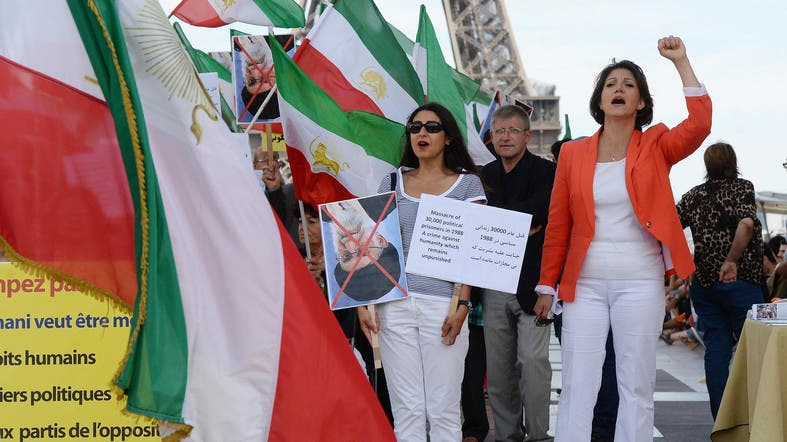- Get link
- X
- Other Apps
How blood of innocents has become an endless nightmare for Iranian regimehttps://english.alarabiya.net/en/perspective/features/2017/07/27/Blood-of-innocents-has-become-an-endless-nightmare-for-Iranian-regime.html

People chant slogans and hold pre-revolutionary Iranian flags in Paris, on August 17, 2013, as they take part in a rally marking the 25th anniversary of the 1988 massacre of Iranian political prisoners. (AFP)
In Iran, 1980s is known as a bloody decade as thousands of political opponents were executed in brutal mass murder.
In the summer of 1988, a massive slaughter took place in Iran’s prisons. Ayatollah Hossein Ali Montazeri, the successor of Khomeini, was dismissed as a result of his objection to this massacre.
In September 2016, an audio tape from a meeting of the late Ayatollah Montazeri with members of the committee of executioners (commonly known by Iranians as death committee) was published by his son, which led to his arrest and prosecution.
In the audio tape, Ayatollah Montazeri described this massacre as the worst crime in the history of the Islamic Republic, and named Ibrahim Raisi, Mostafa Pour Mohammadi, Hossein Ali Nayeri and other coordinators as criminals.
Judgment against Islam
In a recent TV interview, Ali Fallahian, the minister of intelligence during the Rafsanjani government, said: “The view of Mr. Montazeri, who disagreed with Imam (Khomeini), was that these executions will ultimately cause a “historical judgment” against us, a judgement against Islam, so it is to our benefit not to conduct these executions, but Imam said that you must perform your religious duty and don’t wait for the judgment of history.”
The families of victims of 1988 massacre are currently seeking justice for their loved ones who were secretly executed and buried in mass graves at nights without any due process. The call for justice led by Iranian opposition, which started last year, caused a challenge for both of the regime’s factions during the presidential elections.
The created chaos between regime’s factions forced Khamenei to comment in a recent speech that “no one should be allowed to change the place of martyr and henchman in relation to the executions of the 1980s.”
What he meant was that the heads of this government are executioners in the eyes of the Iranian people, and this will create internal and international consequences that must be avoided.
Nimrooz movie
Additionally, state-controlled media released Khamenei’s praises about the “Nimrooz” movie, a production funded by the Iran revolutionary guard corps (IRGC) aimed at demonizing the People’s Mojahedin Organization of Iran (PMOI/MEK), a prominent opposition movement. The reason of making this film was to prevent another uprising similar to 2009, in which the MEK played a pivotal role in organizing protests against the regime.
After the release of the film, former political prisoners and families of executed prisoners condemned the events showed during this film and called it as a distortion of the reality in history.
In another hasty event, the Iranian regime put up a show, a tour of Evin Prison, to international delegations. The purpose of holding this tour for 50 ambassadors of different countries on July 5 was to destroy and wash the traces of the regime’s crimes. Amnesty International called this tour a “crude PR Stunt” and mentioned in a statement that Evin prison is known in the world as a symbol of wide political oppression in Iran.
The executed prisoners of the 1980s were members and supporters of opposition groups of the Iranian regime, such as the MEK, Marxists and Kurds. MEK members and supporters accounted for more than 90 percent of the victims. Beleaguered in Iraq in the post 2003 era, the MEK experienced a very difficult and dangerous situation, particularly over the last decade.
Under such circumstances this movement has been able to attract public sympathy through mass media, especially satellite and Internet. Currently, the Iranians and the International communities have become curious to acquire knowledge about this movement.
Inhuman seige
In face of an inhumane siege and the looming danger of further massacres, members of MEK put up a heroic persistence and defended themselves with bare hands and survived the many plots of their enemies. Eventually, the MEK members exited Iraq and resettled in Albania. Now, the MEK is finding a fast-growing following in Iran, especially among the youth, creating a serious challenge for the Iranian regime.
With the rise of the call for justice for 1988 massacre, the Iranian regime is trying to destroy the evidence of this brutal murder and discourage the youth from joining the opposition movement. It has produced a propaganda film to change the place of martyr and executioner, and destroyed the mass graves of executed prisoners.
The Iranian youth, even the children of regime officials, want to know the reality and the truth of what happened in the 1980s, and the history of the movement that recently held a huge gathering in Paris. Also, they want to know what message it conveys for them.
Meanwhile, Khamenei has ordered to produce another film for Assadollah Lajevardi, the former head of Evin prison known as “Evin hangman,” who was one of the criminals 1988 massacre. “Hopefully, you can do something for Lajevardi as well. He is one of the figures who deserves something. His name was mentioned in this film, but he is one of the persons that we called him ‘strong man’ before,” Khamenei said.
It seems the spilled blood of the innocents who were ruthlessly murdered in Iran is now undermining the foundations and the very existence of the Iranian regime. Sympathy for the victims and their family has now penetrated the depths of the Iranian society and has become an endless nightmare for regime.
As Rahimpour Azghadi, a Khamenei confidant has said, “the events of the ‘80s and 88 will uproot the regime, even if we have the largest missile in store.”
Last Update: Thursday, 27 July 2017 KSA 14:49 - GMT 11:49
‘Mojahed’
(IRGC)
Maryam Rajavi
Maryam Rajavi.
MEK and PMOI/MEKNCRI
MeK(PMOI/MEK)
MojahedinMassoud Rajavi
Rajavi
- Get link
- X
- Other Apps


Comments
Post a Comment